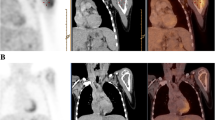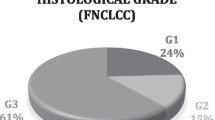Abstract
Purpose
This research aims to investigate the potential of 18F-fluorodeoxyglucose positron emission tomography/computed tomography (FDG PET) to predict pathologic response after neoadjuvant chemotherapy (NAC) and overall survival (OS) of patients with synovial sarcoma in Korea.
Methods
Twenty patients with synovial sarcoma from January 2001 to December 2011 were reviewed retrospectively. All patients underwent pre-treatment FDG PET and tumor removal. Patients were classified with the maximum SUV (SUVmax), metabolic tumor volume (MTV), total lesion glycolysis (TLG), age, sex, histologic subtype, tumor size, NAC, resection margin, and metastasis at diagnosis. Pathologic response was assessed using the French Federation of Cancer Centers system. Statistical analyses were analyzed using the Kaplan-Meier method, log-rank test, Cox proportional hazards regression model, and Mann-Whitney test.
Results
Nine patients (45 %) showed pathologic response, and ten patients survived. Higher SUVmax, higher MTV, higher TLG, monophasic epithelial type, and metastasis at diagnosis were significantly related to poorer OS (p = 0.047, 0.016, 0.016, 0.045, and 0.018, respectively). By multivariate analysis, metastasis at diagnosis was significantly related to poorer OS (p = 0.012/HR = 5.9, 95 % CI 1.47 to 24.1). The SUVmax, MTV, and TLG of the non-responder group were significantly higher than those of the responder group (p = 0.020, 0.020, and 0.020, respectively). There was no significant difference in size between the two groups (p = 0.062).
Conclusions
A higher SUVmax on the pre-treatment scan, monophasic epithelial type, and metastasis at diagnosis were significantly associated with a poorer OS, and pathologic responders showed a higher SUVmax before NAC. The PET parameters can be used to predict OS and pathologic response in patients with synovial sarcomas before NAC.



Similar content being viewed by others
References
Deshmukh R, Mankin HJ, Singer S. Synovial sarcoma: the importance of size and location for survival. Clin Orthop Relat Res. 2004;419:155–61.
Bergh P, Meis-Kindblom JM, Gherlinzoni F, Berlin O, Bacchini P, Bertoni F, et al. Synovial sarcoma: identification of low and high risk groups. Cancer. 1999;85:2596–607.
Singer S, Baldini EH, Demetri GD, Fletcher JA, Corson JM. Synovial sarcoma: prognostic significance of tumor size, margin of resection, and mitotic activity for survival. J Clin Oncol. 1996;14:1201–8.
Lewis JJ, Antonescu CR, Leung DH, Blumberg D, Healey JH, Woodruff JM, et al. Synovial sarcoma: a multivariate analysis of prognostic factors in 112 patients with primary localized tumors of the extremity. J Clin Oncol. 2000;18:2087–94.
Stanelle EJ, Christison-Lagay ER, Healey JH, Singer S, Meyers PA, La Quaglia MP. Pediatric and adolescent synovial sarcoma: multivariate analysis of prognostic factors and survival outcomes. Ann Surg Oncol. 2013;20:73–9.
Trassard M, Le Doussal V, Hacene K, Terrier P, Ranchere D, Guillou L, et al. Prognostic factors in localized primary synovial sarcoma: a multicenter study of 128 adult patients. J Clin Oncol. 2001;19:525–34.
Spurrell EL, Fisher C, Thomas JM, Judson IR. Prognostic factors in advanced synovial sarcoma: an analysis of 104 patients treated at the Royal Marsden Hospital. Ann Oncol. 2005;16:437–44.
Ngahane BH, Baudrand H, Traverse-Glehen A, Freymond N, Guibert B, Pacheco Y, et al. Assessment of prognostic factors of thoracic synovial sarcoma. Rev Mal Respir. 2010;27:93–7.
Cheon GJ, Kim MS, Lee JA, Lee SY, Cho WH, Song WS, et al. Prediction model of chemotherapy response in osteosarcoma by 18 F-FDG PET and MRI. J Nucl Med. 2009;50:1435–40.
Abdelsalam M, Bazarbashi S, Abouzied M, Amin T, Soudy H, Rahal M, et al. Whoe body 18 F-FDG PET predicts progression free and overall survival in squamous cell carcinoma of the esophagus: results of a prospective trials. Hematol Oncol Stem Cell Ther. 2010;3:179–84.
Pallardy A, Bodet-Milin C, Oudoux A, Campion L, Bourbouloux E, Sagan C, et al. Clinical and survival impact of FDG PET in patients with suspicion of recurrent cervical carcinoma. Eur J Nucl Med Mol Imaging. 2010;37:1270–8.
Bar-Shalom R, Valdivia AY, Blaufox MD. PET imaging in oncology. Semin Nucl Med. 2000;30:150–85.
Lisle JW, Eary JF, O’sullivan J, Conrad EU. Risk assessment based on FDG-PET imaging in patients with synovial sarcoma. Clin Orthop Relat Res. 2009;467:1605–11.
Chihara D, Oki Y, Onoda H, Taji H, Yamamoto K, Tamaki T, et al. High maximum standard uptake value (SUVmax) on PET scan is associated with shorter survival in patients with diffuse large B cell lymphoma. Int J Hematol. 2011;93:502–8.
Zhang J, Jia Z, Zhou M, Ragaz J, Zhang YP, Wang BY, et al. The SUVmax for (18)F-FDG correlates with molecular subtype and survival of previously untreated metastatic breast cancer. Clin Nucl Med. 2013;38:256–62.
Yan H, Wang R, Zhao F, Zhu K, Jiang S, Zhao W, et al. Measurement of tumor volume by PET to evaluate prognosis in patients with advanced non-small lung cancer treated by non-surgical therapy. Acta Radiol. 2013;52:646–50.
Larson SM, Erdi Y, Akhurst T, Mazumdar M, Macapinlac HA, Finn RD, et al. Tumor treatment response based on visual and quantitative changes in global tumor glycolysis using PET-FDG imaging. The visual response score and the change in total lesion glycolysis. Clin Positron Imaging. 1999;2:159–71.
Lee P, Weerasuriya DK, Lavori PW, Quon A, Hara W, Maxim PG, et al. Metabolic tumor burden predicts for disease progression and death in lung cancer. Int J Radiat Biol Phys. 2007;69:328–33.
Coindre JM, Terrier P, Bui NB, Bonichon F, Collin F, Le Doussal V, et al. Prognostic factors in adult patients with locally controlled soft tissue sarcoma. A study of 546 patients from the French Federation of Cancer Centers Sarcoma Group. J Clin Oncol. 1996;14:869–77.
Coindre JM, Terrier P, Guillou L, Le Doussal V, Collin F, Ranchere D, et al. Predictive value of grade for metastasis development in the main histologic types of adult soft tissue sarcomas: a study of 1240 patients from the French Federation of Cancer Centers Sarcoma Group. Cancer. 2001;91:1914–26.
Deyrup AT, Weiss SW. Grading of soft tissue sarcomas: the challenge of providing precise information in an imprecise world. Histopathology. 2006;48:42–50.
Lee EY, Khong PL, Tse KY, Chan KK, Chu MM. NganHY. Differentiation of aggressive and indolent subtypes of uterine sarcoma using maximum standardized uptake value. Nucl Med Commun. 2013;34:1185–9.
Coindre JM. Grading of soft tissue sarcomas: review and update. Arch Pathol Lab Med. 2006;130:1448–53.
Krieg AH, Hefti F, Speth BM, Jundt G, Guillou L, Exner UG, et al. Synovial sarcomas usually metastasize after >5 years: a multicenter retrospective analysis with minimum follow-up of 10 years for survivors. Ann Oncol. 2011;22:458–67.
Pack GT, Ariel IM. Synovial sarcoma (malignant synovioma); a report of 60 cases. Surgery. 1950;28:1047–84.
Paulino AC. Synovial sarcoma prognostic factors and patterns of failure. Am J Clin Oncol. 2004;27:122–7.
Pinheiro C, Sousa B, Albergaria A, Paredes J, Dufloth R, Vieira D, et al. GLUT1 and CAIX expression profiles in breast cancer correlate with adverse prognostic factors and MCT1 overexpression. Histol Histopathol. 2011;26:1279–86.
Chung JH, Cho KJ, Lee SS, Baek HJ, Park JH, Cheon GJ, et al. Overexpression of Glut1 in lymphoid follicles correlates with false-positive (18)F-FDG PET results in lung cancer staging. J Nucl Med. 2004;45:999–1003.
Horiuchi C, Tsukuda M, Taguchi T, Ishiguro Y, Okudera K, Inoue T. Correlation between FDG-PET findings and GLUT1 expression in salivary gland pleomorphic adenomas. Ann Nucl Med. 2008;22:693–8.
Higashi K, Ueda Y, Arisaka Y, Sakuma T, Nambu Y, Oguchi M, et al. 18 F-FDG uptake as a biologic prognostic factor for recurrence in patients with surgically resected non-small cell lung cancer. J Nucl Med. 2002;43:39–45.
Ioannidis JP, Lau J. 18 F-FDG PET for the diagnosis and grading of soft-tissue sarcoma: a meta-analysis. J Nucl Med. 2004;44:717–24.
Fuglo HM, Jorgensen SM, Loft A, Hovgaard D, Petersen MM. The diagnostic and prognostic value of (18)F-FDG PET/CT in the initial assessment of high-grade bone and soft tissue sarcoma. a retrospective study of 89 patients. Eur J Nucl Med Mol Imaging. 2012;39:1416–24.
Eary JF, O’Sullivan F, Powitan Y, Chandhurry KR, Vernon C, Bruckner JD, et al. Sarcoma tumor FDG uptake measured by PET and patient outcome: a retrospective analysis. Eur J Nucl Med Mol Imaging. 2002;29:1149–54.
Brenner W, Conrad EU, Eary JF. FDG PET imaging for grading and prediction of outcome in chondrosarcoma patients. Eur J Nucl Med Mol Imaging. 2004;31:189–95.
Hong SP, Lee SE, Choi YL, Seo SW, Sung KS, Koo HH, et al. Prognostic value of 18 F-FDG PET/CT in patients with soft tissue sarcoma: comparisons between metabolic parameters. Skeletal Radiol. 2014;43:641–8.
Choi ES, Ha SG, Kim HS, Ha JH, Paeng JC, Han I. Total lesion glycolysis by 18 F-FDG PET/CT is a reliable predictor of prognosis in soft-tissue sarcoma. Eur J Nucl Med Mol Imaging. 2013;40:1836–42.
Benz MR, Dry SM, Eilber FC, Allen-Auerbach MS, Tap WD, Elashoff D, et al. Correlation between glycolytic phenotype and tumor grade in soft-tissue sarcomas by 18 F-FDG PET. J Nucl Med. 2010;51:1174–81.
Charest M, Hickeson M, Lisbona R, Novales-Diaz JA, Derbekyan V, Turcotte RE. FDG PET/CT imaging in primary osseous and soft tissue sarcomas: a retrospective review of 212 cases. Eur J Nucl Med Mol Imaging. 2009;36:1944–51.
Canter RJ, Qin LX, Maki RG, Brennan MF, Ladanyi M, Singer S. A synovial sarcoma-specific preoperative nomogram supports a survival benefit to ifosfamide-based chemotherapy and improves risk stratification for patients. Clin Cancer Res. 2008;14:8191–7.
Italiano A, Penel N, Robin YM, Bui B, Le Cesne A, Piperno-Neumann S, et al. Neo/adjuvant chemotherapy does not improve outcome in resected primary synovial sarcoma: a study of the French Sarcoma Group. Ann Oncol. 2009;20:425–30.
Al-Hussaini H, Hogg D, Blackstein ME, O’sullivan B, Catton CN, Chung PW. Clinical features, treatment, and outcome in 102 adult and pediatric patients with localized high-grade synovial sarcoma. Sarcoma. 2011. doi:10.1155/2011/231789.
Acknowledgments
This work was supported by the Establishment of the Center for PET Application Technology Development, Korea Institute of Radiological and Medical Sciences (KIRAMS), and by grants from the Ministry of Education, Science and Technology (50441-2013).
Conflict of Interest
Kyoung Jin Chang, Ilhan Lim, Joon Yeun Park, A Ra Jo, Chang Bae Kong, Won Seok Song, Wan Hyeong Jo, Soo Yong Lee, Jae SooKoh, Byung Il Kim, Chang Woon Choi and Sang Moo Lim declare that they have no conflict of interest.
Ethical Statement
This study was approved by the ethics committee in our hospital and was performed in accordance with the ethical standards laid down in the 1964 Declaration of Helsinki and its later amendments. All persons enrolled gave their informed consent prior to their inclusion in the study.
Author information
Authors and Affiliations
Corresponding author
Rights and permissions
About this article
Cite this article
Chang, K.J., Lim, I., Park, J.Y. et al. The Role of 18F-FDG PET/CT as a Prognostic Factor in Patients with Synovial Sarcoma. Nucl Med Mol Imaging 49, 33–41 (2015). https://doi.org/10.1007/s13139-014-0301-5
Received:
Revised:
Accepted:
Published:
Issue Date:
DOI: https://doi.org/10.1007/s13139-014-0301-5




